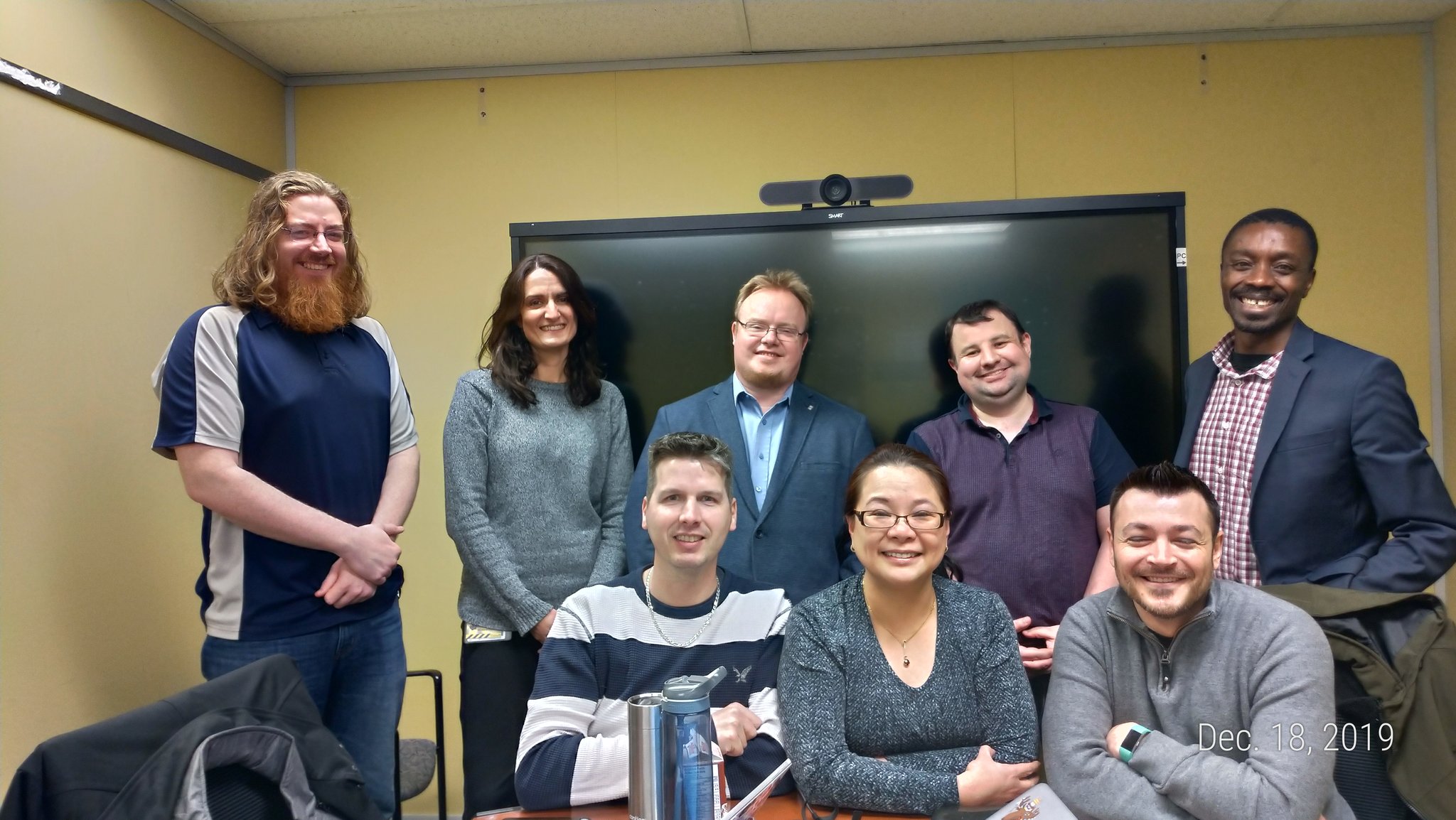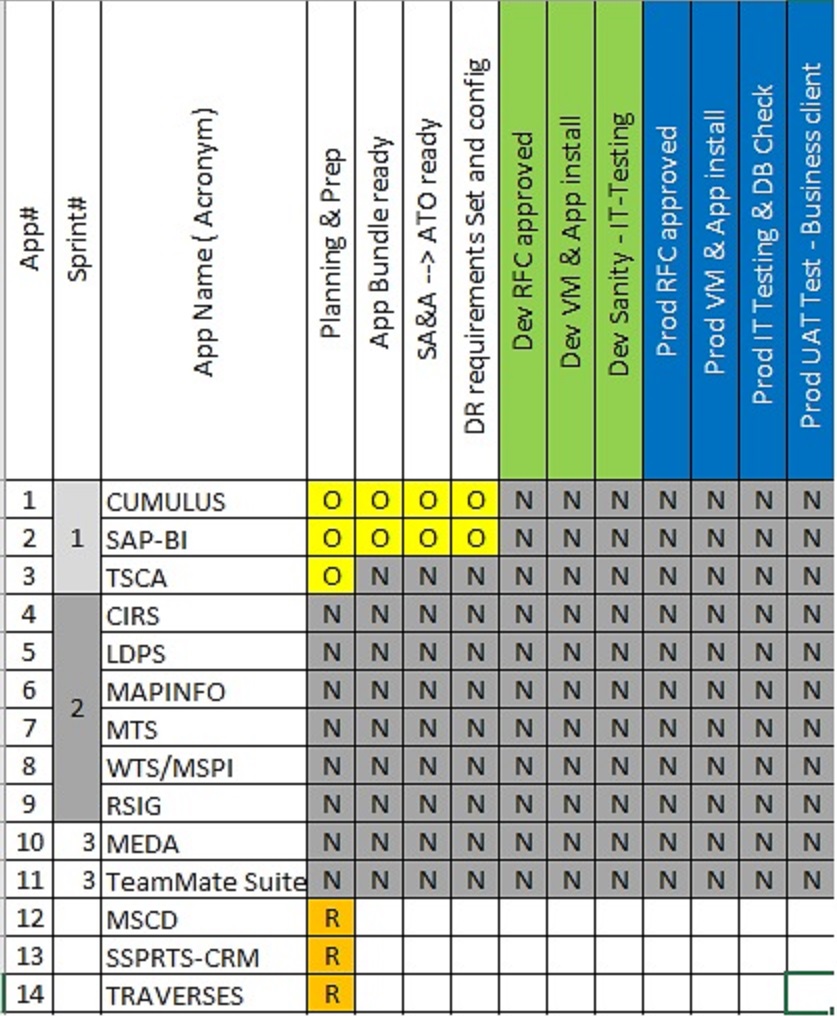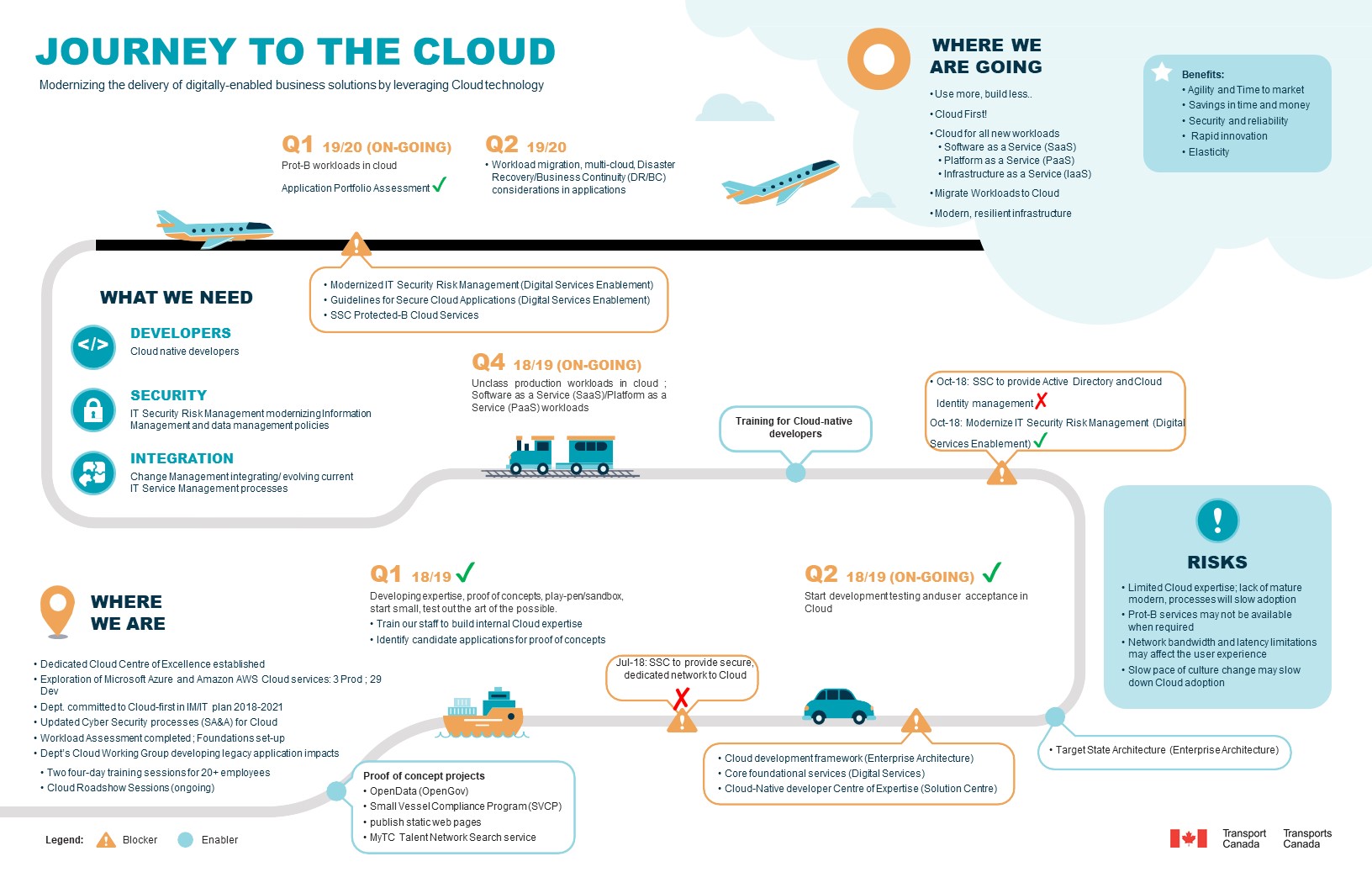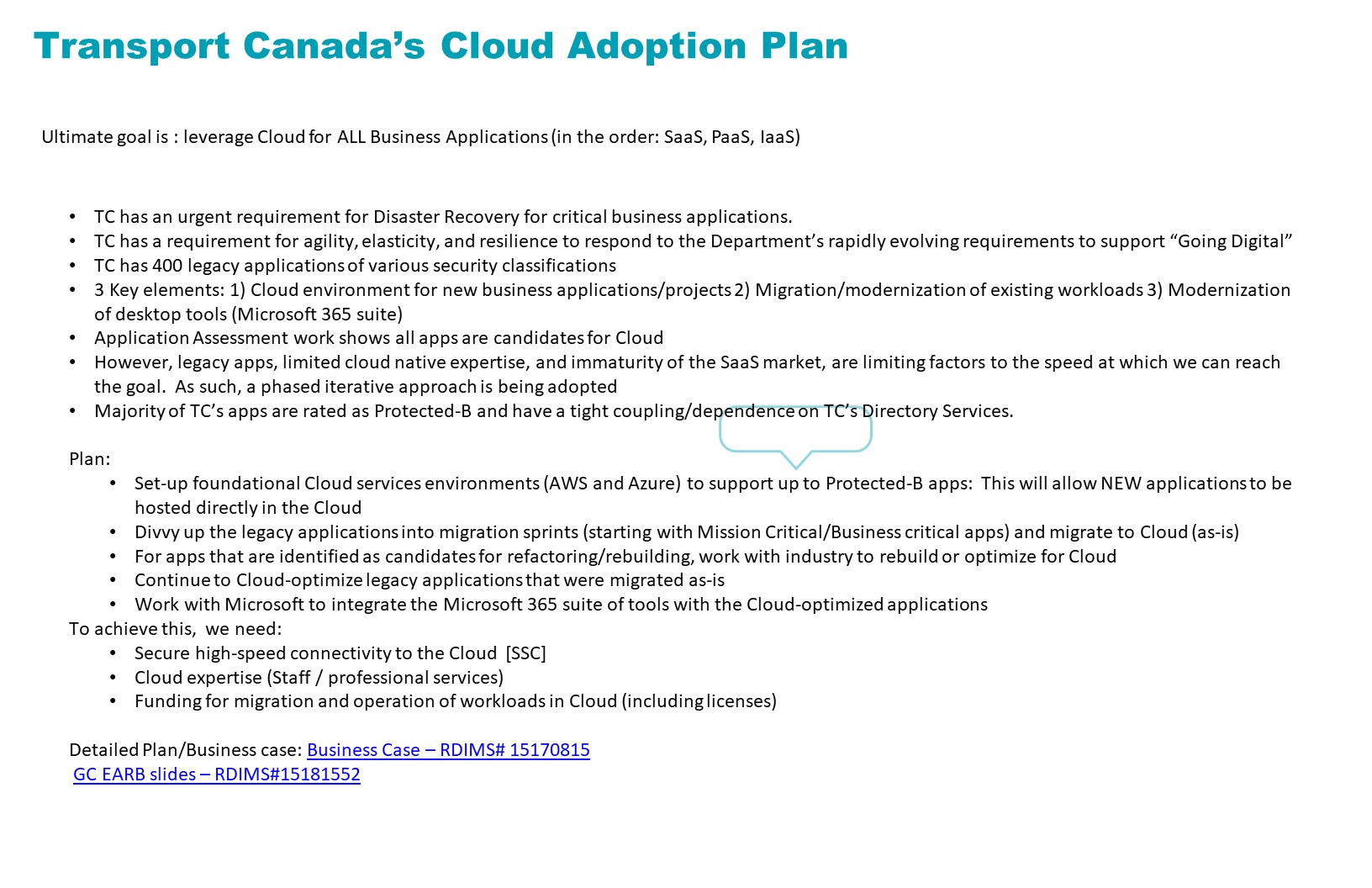Difference between revisions of "Transport Canada (TC) Infrastructure Modernization - Cloud / DR / Workload Migration"
| Line 238: | Line 238: | ||
<br> | <br> | ||
| + | <br> | ||
| + | <br> | ||
| + | <br> | ||
== Activities and Timelines for TC's Cloud Adoption Strategy == | == Activities and Timelines for TC's Cloud Adoption Strategy == | ||
[[File:Activities and Timelines for TC's Cloud Adoption Strategy.jpg|left|thumb|600x600px|Activities and Timelines for TC's Cloud Adoption Strategy]] | [[File:Activities and Timelines for TC's Cloud Adoption Strategy.jpg|left|thumb|600x600px|Activities and Timelines for TC's Cloud Adoption Strategy]] | ||
[[File:Activities and Timelines for TC's Cloud Adoption Strategy slide 2.jpg|left|thumb|600x600px]] | [[File:Activities and Timelines for TC's Cloud Adoption Strategy slide 2.jpg|left|thumb|600x600px]] | ||
Revision as of 14:31, 24 January 2020
Transport Canada (TC) IT Infrastructure Modernization
The project is to deliver a complete modern infrastructure environment for TC applications in the Cloud. This requires building a foundational Cloud environment, planning and execution of a workload migration plan, and establishing and operationalize a Disaster Recovery Management Program. In conjunction with SSC, establishment of foundational services (secure network to cloud and authentication services) is required.
The Cloud will provide TC with a modern, scalable, and resilient infrastructure which offers disaster recovery and rapid time to market to support the promotion of a safe and secure, efficient and environmentally responsible transportation system in Canada.
This project is meant to address the business needs and opportunities of:
- Providing recovery services for IT in the event of a disaster. This will ensure that the delivery of critical services affecting the safety, security, and economic viability of Canadian citizens continues in a normal operations mode in the event of a disaster;
- Responding to the Cloud First principle and direction from TBS for delivery of Digital Services;
- Responding to demands for increased IT capabilities and increased IT capacity to support department’s programs;
- Adoption of DevOps and modern development methodologies that are enhanced by Cloud services – working in Agile, Open, Collaboration; and,
- Implementing a disaster recovery management program in response to the TBS Policy on Government Security to provide IT service continuity in a timely and efficient manner.
The key deliverables are:
Modernized TC IT environment using Cloud solutions;
- A migration of all applications/systems within the Workload Migration (WLM) initiative to the Cloud;
- Application development and support model modernization to enable Cloud solutions providing efficiencies in delivery time and cost; and,
A validated and maintained Disaster Recovery Management framework in place.
Project Status
This project will use where possible the Agile methodology, following the TC Project Management Office Framework 4 Gate model.
TC Azure Cloud foundation build activities and planning for the migration of applications into the Cloud are on track; overall the project is behind schedule due to the issue of the delay of secure network connectivity (a Protected B "Cloud to Ground" connection) and authentication services (Active Directory - AD). This issue is also causing delays to operationalizing the TC Cloud Foundational Environments and other projects (GC-Docs, ZEV). The Protected B Cloud environment (Azure) has been granted a Protected B "Authority to Operate" (ATO) for applications not requiring "Cloud to Ground" connectivity and AD. In order to progress and to validate the migration process, a list of unclassified applications for migration to the Cloud has been created, that do not require "Cloud to Ground" connectivity and AD to an SSC Enterprise Data Centre. Phase 3 of the project (define the migration process and migrate first set of applications) has contract approval and is now commencing. The project has been reviewed and approved by TBS via the GC-EARB review process.
| Milestones | Initial Target Date | Forecast Date | Completion Date | Comments |
| Project Start Date | 2017-10-26 | 2017-10-26 | ||
| Discovery & Analysis for Disaster Recovery (DR) | 2018-10-05 | 2018-10-05 | 2018-10-05 | Complete: Initial research for establishing a Disaster Recovery Program for TC |
| Gate 0 Phase 1: Discovery and Initial Cloud Foundation build | 2019-04-29 | 2019-04-01 | 2019-04-01 | Complete: Task awarded to Microsoft to collect information for Cloud environment, assess the TC landscape, and create the initial working environment for TC applications |
| Gate 1 Phase 2: Application Target State Assessment | 2019-09-20 | 2019-09-20 | 2019-09-20 | Complete: All business systems assessed and assigned a Cloud target state |
| Network Connectivity to the Cloud | 2018-07-16 | 2020-04-30 | While TC had requested an initial target date of July, 2018, per the SCED project, TC is scheduled to have the connectivity in April, 2020. Until the connectivity is available, TC cannot put into production any applications into the Cloud that require connectivity to an Enterprise data centre | |
| Cloud Foundation Build | 2019-04-01 | 2019-10-18 | 2019-10-18 | Complete (minus "Cloud to Ground" "SCED" networking infrastructure): This is the Cloud Working environment for TC applications |
| Gate 2 Phase 3 – Project Execution approval | 2020-03-01 | 2020-03-01 | ||
| First Sprint of migration of applications into cloud (Unclassified and not requiring connectivity) | 2020-01-30 | 2020-01-30 | ||
| Migration of Business Systems to Cloud | 2023-03-31 | 2023-03-31 | Remainder of systems migrated via Agile processes using sprints | |
| Disaster Recovery Plans for all applications completed | 2023-03-31 | 2023-03-31 | ||
| DR initial Exercise | 2022-03-30 | 2022-03-30 | First full scale exercise | |
| Gate 3 Phase 4 - Project Completion Date - Approval for Project close | 2023-03-31 | 2023-03-31 | TC signoff of delivery of all services | |
| Gate 4 - Project Close | 2023-04-15 | 2023-04-15 |
Key Accomplishments
Dedicated TC Cloud Centre of Excellence (#TC3OE) has been established
- Deployed 4 production applications in the Cloud (Open Data, Alexa Recalls, TC Search, Navigable Waters Act Registry)
- Deployed 1 Protected B application in pilot – MISS (Major Investigations Specialists Software)
- 40 application workloads currently in pre-production (development, testing, pilot) in Cloud
- Completed implementation of security controls required for Protected-B Cloud environment
- Completed assessment of TC's applications for readiness to be migrated to the Cloud
- Contracted industry Cloud expertise to assist to create, configure, and train TC FTE staff
- Established the foundational Cloud Environment (Hybrid Cloud Management (HCM)) to start accepting workloads
- As part of Culture change to adopt Cloud, 37 (formal and informal) Training sessions, 11 Technical Talks, 33 Awareness building roadshows, and four TC-wide Cloud engagement sessions have been completed
- TC is sharing with other GC Agencies and Departments the Azure Network Template Generator via the GitHub repository
- Adoption of DevOps and modern development methodologies that are enhanced by Cloud services – Working in Agile, Open, Collaboration
Overview of Transport Canada’s Cloud Centre of Excellence (#TC3OE)
TC3OE is Transport Canada’s Cloud Centre of Excellence –the group is responsible to enable the delivery of modern digital solutions by leveraging the Agility, Flexibility, Elasticity, and Disaster Recovery features of Cloud technologies.
The team supports and maintains the Cloud foundational infrastructure, and aids designers in the planning, procurement, configuration and integration of Cloud services, so that TC clients can quickly address their rapidly changing business needs.
#TC3OE can be contacted via email at: TC.Cloud-Infonuagique.TC@tc.gc.ca
Below is a photo of our outstanding team!
Challenges – Risks and Issues
Risks:
- Resourcing is a high risk, since there is a potential of a lack of resources 1) for application developers due to other projects and schedules colliding with major deliverables; 2) in obtaining support resources for the Cloud due to this skill set being in high demand at this time. – Impact: Medium – Probability: High
Mitigation - The team will strive to mitigate this risk through high-level program management and close coordination with Managers and Directors. Support from senior management across various projects will be needed to ensure that initiatives, inter-dependencies and resource conflicts are highlighted. Senior management will also need to get involved to prioritize and resolve conflicts as required.
- Cloud technology is a new paradigm for TC developers, and as well is a fast changing technology environment for support staff, creating a steep learning curve. - Impact: Medium – Probability: Medium
Mitigation - TC management must include Cloud based training for staff in the training plans, as well, staff needs to take advantage of the vendor workshops, demos, and other venues that the Cloud support team has organized.
- Schedule is a low impact risk as there are mitigation plans in place for the currently listed risks (connectivity, resourcing). - Impact: Low – Probability: High
Mitigation - The Project Manager will mitigate the risk by conducting weekly meetings and focus on which deliverables to manage, while at the same time keeping the project end date on track. Mitigation plans are in place for schedule delays due to the current risks. Scheduling challenges are immediately communicated to senior management.
Issues:
- Missing secure network connectivity "Cloud to Ground".
Resolution Plan: Re-order activities to migrate workloads that have minimum dependency on Network requirements first. Working to ensure TC is on the next wave of SCED planning.
Guidance and Documentation
- Frequently Asked Questions
- [Cloud Adoption Strategy]
- [Journey to the cloud]
- TC Cloud Corner page
- The Azure Network Template Generator is now released to GitHub at: https://github.com/canada-ca/accelerators_accelerateurs-azure
Workload Migration Categorizations (Business Applications in Scope)
- Data Source from the previous Microsoft Assessment
| Security Classification | No Active Directory Dependency | No Connectivity | Requires Active Directory | Requires Connectivity with EDC | SQL Database | Total |
| Unclassified | 84 | 21 | 40 | 103 | 7 | 124 |
| Protected A | 87 | 9 | 60 | 138 | 5 | 147 |
| Protected B | 46 | 8 | 9 | 47 | 4 | 55 |
| Total | 217 | 38 | 109 | 288 | 16 | 326 |
Application Workload Migration via Agile Sprints
Current project activity is to define the migration process and migrate the first set of applications. The phase has 4 sprints of 4 weeks each (refinement of application choice and schedule can occur as per an iterative agile process).
- The project is currently on track in Sprint #1.





